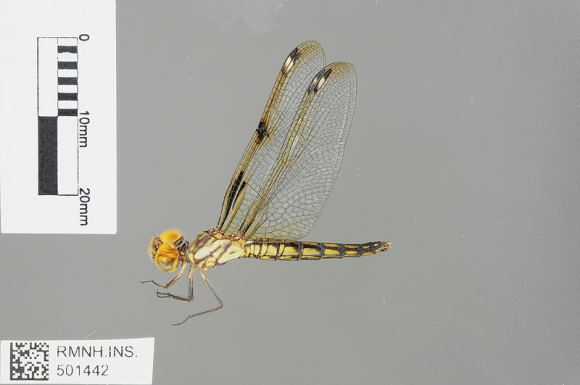Palpopleura deceptor (Calvert, 1899)
Deceptive Widow
Type locality: Sheikh Husein, Ethiopia
Diagnosis
Male is most similar to P. jucunda by (a) pale face contrasting with dark metallic dorsum of frons; (b) pale sides of thorax with dark stripes; (c) basal black on wings fragmented by clear areas and/or pale veins, does not extend beyond node, at most isolated dark marking around node. However, differs by (1) much larger size, Hw 24-29 mm; (2) all veins in wings dark rather than pale with dark markings; (3) 1 rather than 2-5 Cux in Fw and Hw; (4) cubital space and anal field of wings clear rather than filled with black. [Adapted from Dijkstra & Clausnitzer 2014]
Habitat description
Standing and mostly temporary waters in open landscapes, open areas in forest or shaded by gallery forest. Usually with emergent vegetation and often coarse detritus and a soft (like muddy) bottom. From 0 to 2000 m above sea level, but mostly below 1500, although possibly up to 2400.
Distribution

Male © Jens Kipping
 Abdominal segment 2 (lateral view) |
Map citation: Clausnitzer, V., K.-D.B. Dijkstra, R. Koch, J.-P. Boudot, W.R.T. Darwall, J. Kipping, B. Samraoui, M.J. Samways, J.P. Simaika & F. Suhling, 2012. Focus on African Freshwaters: hotspots of dragonfly diversity and conservation concern. Frontiers in Ecology and the Environment 10: 129-134.
Barcode specimen(s):

Female; Liberia, Nimba County, East Nimba Nature Reserve © Dijkstra, K.-D.B.

Male; Democratic Republic of Congo, Katanga, © Dijkstra, K.-D.B.
References
- Calvert, P.P. (1899). Neuropterous insects collected by Dr. A. Donaldson Smith in Northeastern Africa. Ecological Entomology, 51, 228-244. [PDF file]
- Ris, F. (1921). The Odonata or Dragonflies of South Africa. Annals South African Museum, XVIII, 245-452. [PDF file]
- Pinhey, E.C.G. (1961). Dragonflies (Odonata) of Central Africa. Occasional Papers Rhodes-Livingstone Museum, 14, 1-97. [PDF file]
- Pinhey, E.C.G. (1966). Check-list of dragonflies (Odonata) from Malawi, with description of a new Teinobasis Kirby. Arnoldia, 2, 1-24. [PDF file]
- Schouteden, H. (1934). Annales Musee Congo belge Zoologie 3 Section 2, 3, 1-84. [PDF file]
- Lieftinck, M.A. (1969). Odonates Anisoptères - Odonata Anisoptera. Explor. hydrob. Lac Bangweolo and Luapula, 14, 1-64. [PDF file]
Citation: Dijkstra, K.-D.B (editor). African Dragonflies and Damselflies Online. http://addo.adu.org.za/ [2024-07-27].

